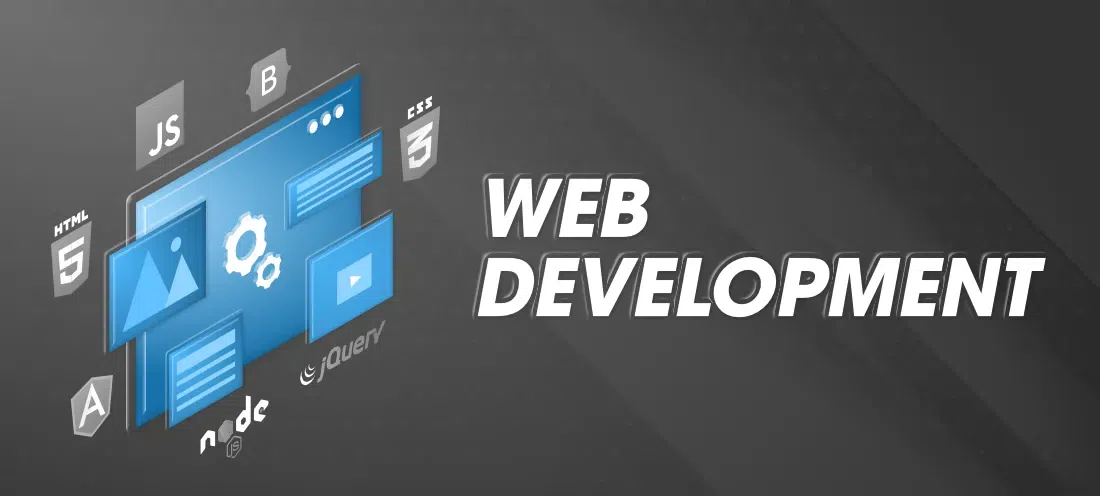Web Development

Frontend Development
The Face of the Web. The part of a website where the user interacts directly is termed as front end. This involves designing the structure, layout, and behavior of the website It is also referred to as the ‘client side’ of the application.
Frontend Technologies
- HTML: HTML stands for HyperText Markup Language. It is used to design the front end portion of web pages using markup language. It acts as a skeleton for a website since it is used to make the structure of a website.
- CSS: Cascading Style Sheets fondly referred to as CSS is a simply designed language intended to simplify the process of making web pages presentable. It is used to style our website.
- JavaScript: JavaScript is a scripting language used to provide a dynamic behavior to our website.
- Bootstrap: Bootstrap is a free and open-source tool collection for creating responsive websites and web applications. It is the most popular CSS framework for developing responsive, mobile-first websites. Nowadays, the websites are perfect for all browsers (IE, Firefox, and Chrome) and for all sizes of screens (Desktop, Tablets, Phablets, and Phones).
Frontend Frameworks/Libraries
- React.js : A popular JavaScript library for building dynamic, component-based user interfaces.
- Angular : A full-fledged framework for building single-page applications (SPAs), with features like two-way data binding and dependency injection.
- Vue.js : A progressive JavaScript framework that is flexible and can be used for building both simple and complex user interfaces.
Backend Development
The Backbone of the Web. Backend is the server side of a website. It is part of the website that users cannot see and interact with. It is the portion of software that does not come in direct contact with the users. It is used to store and arrange data.
Server-side Programming Languages and Frameworks
- PHP: PHP is a server-side scripting language designed specifically for web development.
- Java: Java is one of the most popular and widely used programming languages. It is highly scalable.
- Python: Python is a programming language that lets you work quickly and integrate systems more efficiently.
- Node.js: Node.js is an open source and cross-platform runtime environment for executing JavaScript code outside a browser.
- Ruby: Ruby is a dynamic, reflective, object-oriented, general-purpose programming language.
- C# : C# is a high-level, general-purpose programming language developed by Microsoft.
Backend Languages | Backend Frameworks |
|---|---|
Databases
APIs (Application Programming Interfaces)
Full Stack Development
Full-stack development refers to the practice of developing both the frontend and backend of a website or web application. Full-stack developers have a deep understanding of both areas and can build end-to-end solutions.
Full Stack Technologies:
- MERN Stack : MongoDB, Express.js, React, Node.js
- MEAN Stack : MongoDB, Express.js, Angular, Node.js
- JAMstack : JavaScript, APIs, Markup
- Django Stack : Django, MySQL/PostgreSQL, HTML/CSS/JavaScript
- Spring Boot Stack : Spring Boot, MySQL/PostgreSQL, Java
- LAMP Stack : Linux, Apache, MySQL, PHP
- LEMP Stack : Linux, Engine-X, MySQL, PHP

Databases
In web technology, a database is a structured collection of data that is stored electronically and accessed via a web application. It serves as the backend component where data is stored, managed, and retrieved. Databases can be relational (like MySQL, PostgreSQL) using structured tables and SQL for queries, or non-relational (like MongoDB, CouchDB) which store data in flexible, document-oriented formats. They enable web applications to handle dynamic content, user data, transactions, and more by providing efficient storage, retrieval, and manipulation capabilities. Database management systems (DBMS) are used to interact with the database, ensuring data integrity, security, and performance.
1. Relational Databases
A relational database stores data in tables, similar to a spreadsheet, where each table has rows and columns. The rows hold individual records, and the columns define the data attributes. Tables can be linked to each other through special keys, allowing related data to be connected.
- Postgre SQL : PostgreSQL is a powerful, open-source relational database that supports advanced SQL features and complex queries. It handles structured data, ensures ACID compliance, and is known for its reliability and extensibility.
- MariaDB : MariaDB is an open-source relational database that evolved from MySQL, offering improved performance, security, and features. It supports SQL queries, ACID compliance, and is highly compatible with MySQL.
- MySQL : MySQL is an open-source relational database management system that uses SQL for managing structured data. It’s known for its reliability, ease of use, and performance, widely used in web applications.
2. NoSQL Databases
A NoSQL database stores data in a flexible, non-tabular format, unlike traditional relational databases. Instead of using tables with rows and columns, NoSQL databases might use documents, key-value pairs, wide-columns, or graphs to store data. This allows them to handle large amounts of unstructured or semi-structured data efficiently. They are designed to scale easily and manage big data applications.
- Mongodb : MongoDB is a NoSQL database storing data in JSON-like documents. It handles unstructured data, supports powerful queries, and scales easily across servers, making it popular for flexible, scalable applications.
- Cassandra : Apache Cassandra is an open-source NoSQL database that is used for handling big data. It has the capability to handle structure, semi-structured, and unstructured data.
- Redis : Redis is an in-memory NoSQL database known for its speed. It supports various data structures like strings, hashes, and lists, making it ideal for caching, real-time analytics, and messaging.
Related Notes
-
Web Development
March 6, 2025 -
HTML note
March 6, 2025 -
CSS Notes for Beginners
March 7, 2025 -
CSS Tutorial
March 18, 2025 -
Basic SQL queries explained in an easy way
March 24, 2025
India Holidays 2025
- January
- January 1 (Wednesday) - New Year's Day
- January 6 (Monday) - Guru Gobind Singh Jayanti
- January 14 (Tuesday) - Pongal, Makar Sankranti, Hazarat Ali’s Birthday
- January 26 (Sunday) - Republic Day
- February
- February 2 (Sunday) - Vasant Panchami
- February 12 (Wednesday) - Guru Ravidas Jayanti
- February 19 (Wednesday) - Shivaji Jayanti
- February 26 (Wednesday) - Maha Shivaratri
- March
- March 13 (Thursday) - Holika Dahan
- March 14 (Friday) - Holi, Dolyatra
- March 28 (Friday) - Jamat Ul-Vida
- March 30 (Sunday) - Chaitra Sukhladi, Ugadi, Gudi Padwa
- March 31 (Monday) - Ramzan Id/Eid-ul-Fitr
- April
- April 6 (Sunday) - Rama Navami
- April 10 (Thursday) - Mahavir Jayanti
- April 18 (Friday) - Good Friday
- May
- May 12 (Monday) - Buddha Purnima
- June
- June 7 (Saturday) - Bakrid/Eid ul-Adha
- July
- July 6 (Sunday) - Muharram/Ashura
- August
- August 9 (Saturday) - Raksha Bandhan
- August 15 (Friday) - Independence Day, Janmashtami, Parsi New Year
- August 16 (Saturday) - Janmashtami
- August 27 (Wednesday) - Ganesh Chaturthi
- September
- September 5 (Friday) - Milad un-Nabi/Id-e-Milad, Onam
- September 29 (Monday) - Maha Saptami
- September 30 (Tuesday) - Maha Ashtami
- October
- October 1 (Wednesday) - Maha Navami
- October 2 (Thursday) - Mahatma Gandhi Jayanti, Dussehra
- October 7 (Tuesday) - Maharishi Valmiki Jayanti
- October 10 (Friday) - Karva Chauth
- October 20 (Monday) - Naraka Chaturdasi, Diwali
- October 22 (Wednesday) - Govardhan Puja
- October 23 (Thursday) - Bhai Duj
- November
- November 5 (Wednesday) - Guru Nanak Jayanti
- November 24 (Monday) - Guru Tegh Bahadur’s Martyrdom Day
- December
- December 24 (Wednesday) - Christmas Eve
- December 25 (Thursday) - Christmas